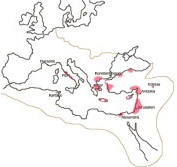John the Presbyter
John the Presbyter (Greek ὁ πρεσβύτερος, literally: the elder ; as an office: the elder ) (* around 60 ; † after 130 AD ) was an important figure in the early Christian Church. He worked in Asia Minor ( Ephesus region ).
To person

Papias of Hierapolis reported (around 100 AD) that he considered John the Presbyter to be an important ecclesiastical authority:
- But when anyone came to succeed the presbyters, I asked [Papias] about the teachings of the elders - what did Andrew or what did Peter say, or what did Philip or Thomas or James or John or Matthew or any other of the disciples have said of the Lord; and what do Aristion and the presbyter John, also disciples of the Lord, say . Because I was of the opinion that the books (reports) would not be of as much use to me as the (reports) of the living and lasting voice.
Richard Bauckham considered two different persons in the two names given to 'John'; on the basis of this text he sees in John the Presbyter a disciple of Jesus who survived the apostles and was still alive when Papias made his research (according to Bauckham between 80 and 90 AD) and the main author of the Gospel of John and all three Epistles of John .
Werner de Boor , on the other hand, is of the opinion that both mentions of 'John' are about the same person: “Both are 'old people' and both are 'disciples of the Lord'. So it will be the same person in both sentences of Papias. ”According to him, John the presbyter is identical to the apostle and evangelist John .
John the Presbyter may have been of Jewish origin. His mother tongue was Greek . He was buried in Ephesus.
Fonts
John the Presbyter is considered to be the author of the 2nd and 3rd Epistles of John .
literature
- Hugh J. Schonfield : Preface to the Letters of John the Elder . In: Hugh J. Schonfield: The Original New Testament. The definitive translation of the New Testament in 2000 years. Element Books Ltd, Shaftesbury, Dorset, UK. 1998, ISBN 1-86204-252-7 , pp. 533f
- Papias of Hierapolis : Fragments I. [1] .
Individual references and comments
- ^ Robert W. Yarbrough : The Date of Papias: A Reassessment. In: Journal of the Evangelical Theological Society. Volume 26, Number 2, 1983, pp. 181-191 ( PDF ).
- ↑ Enrico Norelli : Papia di Hierapolis, Esposizione degli Oracoli del Signore: I frammenti (= Letture cristiane del primo millennio. Volume 36), Paoline, Milan 2005, ISBN 88-315-2752-5 , pp. 38-54.
- ↑ Ulrich HJ Körtner : Papias of Hierapolis . In: Theologische Realenzyklopädie (TRE). Volume 25, de Gruyter, Berlin / New York 1995, ISBN 3-11-014712-2 , pp. 641-644.
- ↑ Papias of Hierapolis. In: Eusebius von Caesarea : Kirchengeschichte III , 39 (4), Kösel-Verlag, Munich, study edition 1997.
- ^ Richard Bauckham : Jesus and the Eyewitnesses. 2006.
- ↑ Werner de Boor : The Gospel of John. Part 1: Chapters 1 to 10 in Wuppertaler Studienbibel, R. Brockhaus Verlag, Wuppertal 1968, pp. 18-20.
- ↑ Derived from the style of his writings (e.g. 2nd and 3rd John ).
- ↑ Eusebius of Caesarea: Church history III. 39 (6).
- ^ Dionysius of Alexandria . In: Eusebius of Caesarea: Church history VII. 25 (16).
- ^ Hugh J. Schonfield : Preface to the Letters of John the Elder . In: The Original New Testament. The definitive translation of the New Testament in 2000 years. Element Books Ltd, Shaftesbury, Dorset, UK. 1998, p. 533f.
| personal data | |
|---|---|
| SURNAME | John the Presbyter |
| BRIEF DESCRIPTION | Probable author of the 2nd and 3rd letters of John |
| DATE OF BIRTH | at 60 |
| PLACE OF BIRTH | Asia Minor |
| DATE OF DEATH | at 130 |
| Place of death | Ephesus |